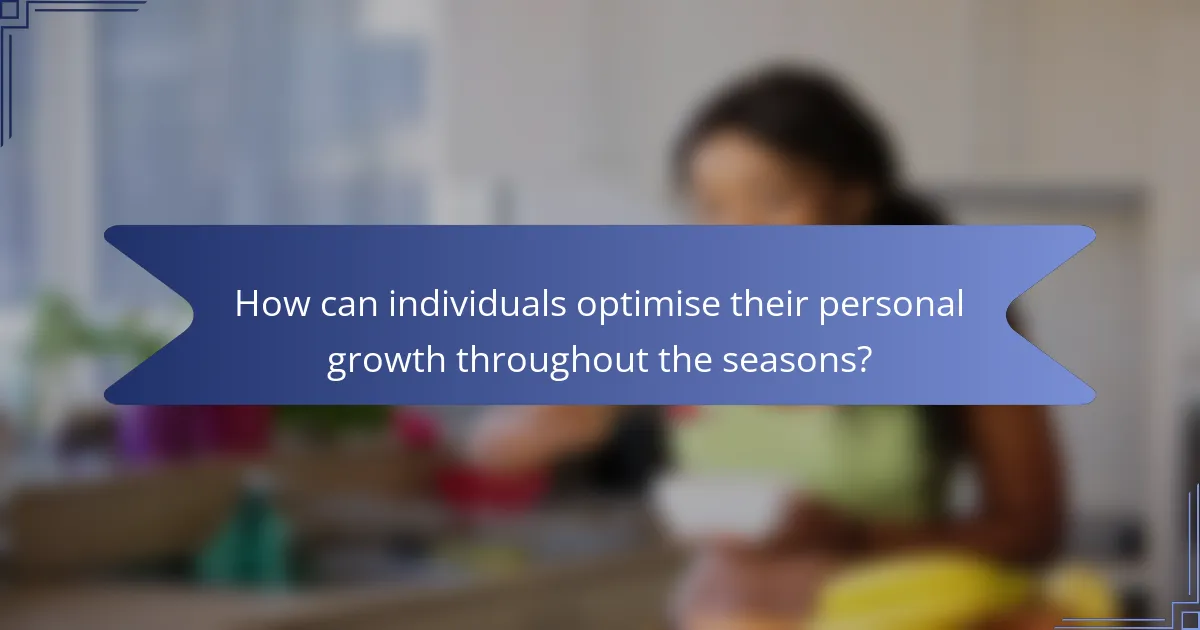Changing seasons can profoundly influence our lifestyle and personal growth through psychological adaptation. Seasonal changes impact mood and behaviour, fostering emotional resilience and cognitive flexibility. Each season offers unique opportunities for renewal, reflection, and social interaction, enhancing overall well-being. By aligning activities and mindset with these shifts, individuals can optimise their personal development throughout the year.

How do changing seasons impact psychological adaptation?
Changing seasons significantly impact psychological adaptation, influencing mood and behaviour. Seasonal changes can lead to variations in mental health, with some individuals experiencing seasonal affective disorder. The transition from winter to spring often fosters increased energy and motivation, while autumn may evoke feelings of nostalgia or melancholy. Research indicates that exposure to natural light during longer days can enhance overall well-being. Adapting to seasonal shifts encourages personal growth, resilience, and a deeper connection to nature.
What are the psychological effects of seasonal changes?
Changing seasons significantly impact our psychological well-being and personal growth. Seasonal changes can lead to mood fluctuations, with winter often causing seasonal affective disorder. The transition to warmer months typically enhances energy and motivation.
Research indicates that exposure to natural light during spring and summer can improve mood and cognitive function. Conversely, the shorter days of autumn and winter may lead to feelings of sadness or lethargy.
Adapting to these seasonal shifts can foster resilience and personal growth. Individuals who engage in outdoor activities during pleasant weather often report higher levels of happiness.
Overall, understanding these psychological effects can help individuals navigate lifestyle changes and enhance their mental health throughout the year.
How does seasonal affective disorder influence personal development?
Seasonal affective disorder significantly hampers personal development by impacting mental health and motivation. Individuals may experience decreased energy and focus during winter months, leading to stagnation in personal growth. Research indicates that about 5% of the population suffers from this condition, primarily affecting women. As a result, developing coping strategies, such as light therapy or regular exercise, can enhance resilience and promote positive changes. Understanding these influences can empower individuals to adapt and thrive despite seasonal challenges.
What are the symptoms of seasonal affective disorder?
The symptoms of seasonal affective disorder include persistent sadness, fatigue, changes in sleep patterns, and difficulty concentrating. These symptoms often emerge during specific seasons, particularly winter, when daylight hours are shorter. Affected individuals may experience weight gain or loss, social withdrawal, and a lack of interest in previously enjoyed activities. Understanding these symptoms can aid in recognizing the disorder and seeking appropriate treatment.
How can seasonal affective disorder be treated?
Seasonal affective disorder can be treated through light therapy, psychotherapy, and medication. Light therapy involves exposure to bright artificial light to mimic natural sunlight, helping regulate mood. Psychotherapy, especially cognitive behavioural therapy, addresses negative thought patterns associated with seasonal changes. Antidepressant medications may be prescribed for more severe cases. Regular physical activity and a healthy diet also support overall mental well-being.
What role does environment play in seasonal lifestyle changes?
The environment significantly influences seasonal lifestyle changes by affecting mood, behaviour, and activities. Seasonal variations in temperature and daylight impact psychological adaptation, prompting shifts in routines and social interactions. For instance, longer days in summer encourage outdoor activities, while winter’s shorter days may lead to increased indoor time and reflection. Changes in natural surroundings can foster personal growth through new experiences and adaptations to varying conditions.
How do daylight hours affect mood and motivation?
Daylight hours significantly influence mood and motivation, primarily through exposure to natural light. Increased daylight enhances serotonin production, which boosts mood and energy levels. Conversely, reduced daylight can lead to feelings of lethargy and sadness, commonly associated with Seasonal Affective Disorder (SAD).
Research indicates that longer daylight hours correlate with higher productivity and improved mental health. People tend to engage more in outdoor activities, fostering social interactions that further enhance motivation. Additionally, the psychological adaptation to changing seasons can lead to personal growth, as individuals learn to cope with varying light conditions and their effects on well-being.
What environmental factors contribute to seasonal stress?
Changing seasons can significantly contribute to seasonal stress through various environmental factors. These include fluctuations in daylight, temperature changes, and alterations in social activities. Reduced sunlight during winter months can lead to Seasonal Affective Disorder, impacting mood and energy levels. Temperature variations can affect physical comfort and outdoor activities, leading to lifestyle changes that may increase stress. Additionally, seasonal transitions often disrupt routines and social interactions, creating feelings of isolation or anxiety. Understanding these factors can help individuals adapt their lifestyles for better psychological resilience.

What are the universal attributes of seasonal psychological adaptation?
Seasonal psychological adaptation involves universal attributes such as emotional resilience, cognitive flexibility, and behavioural adjustment. These attributes enable individuals to navigate changes in environment, mood, and lifestyle effectively. Emotional resilience helps manage stress during seasonal transitions, while cognitive flexibility allows for new perspectives on challenges. Behavioural adjustment involves modifying routines to align with seasonal demands, enhancing overall well-being.
How does the body physiologically respond to seasonal changes?
The body physiologically responds to seasonal changes through various adaptations. These include alterations in hormone levels, such as increased melatonin production during shorter days, affecting sleep patterns and mood. Seasonal changes also influence immune function, with some studies indicating that certain immune responses may be heightened in winter. Additionally, the body adjusts its metabolism, potentially leading to weight fluctuations as energy needs vary with temperature. Overall, these physiological responses play a crucial role in how individuals adapt to changing seasons, impacting lifestyle and personal growth.
What common coping strategies are used during seasonal transitions?
Common coping strategies during seasonal transitions include adjusting routines, practising mindfulness, engaging in physical activity, and maintaining social connections. These strategies help individuals adapt psychologically to changes in weather and daylight. For example, establishing a consistent sleep schedule can enhance mood stability. As a result, individuals may experience improved emotional resilience and personal growth.

What unique attributes influence personal growth through seasons?
Changing seasons uniquely influence personal growth by affecting mood, motivation, and adaptability. Seasonal changes can enhance self-awareness and resilience. For instance, spring often inspires renewal and creativity, while winter encourages introspection. Research indicates that exposure to varying weather conditions can impact mental health, promoting growth through psychological adaptation. These shifts can lead to new habits, perspectives, and emotional responses that contribute to overall development.
How do individual personality traits affect seasonal adaptation?
Individual personality traits significantly influence how people adapt to seasonal changes. Traits such as openness, conscientiousness, and neuroticism can determine responses to environmental shifts. For instance, individuals high in openness may embrace change, enhancing personal growth during transitions, while those with high neuroticism may struggle, leading to stress. Understanding these dynamics can improve lifestyle choices and psychological resilience throughout the seasons.
What unique seasonal rituals promote personal growth?
Unique seasonal rituals can significantly enhance personal growth by aligning psychological adaptation with nature’s cycles. For instance, spring cleaning symbolizes renewal and decluttering, fostering mental clarity. Autumn harvest festivals promote gratitude and reflection, encouraging self-assessment. Winter solstice celebrations emphasise introspection and goal-setting, paving the way for personal development. Each ritual serves as a unique opportunity to engage with changing seasons, facilitating emotional and psychological growth through intentional practices.
How can mindfulness practices be adapted seasonally?
Mindfulness practices can be adapted seasonally by aligning techniques with seasonal changes. In spring, focus on renewal through outdoor meditation. Summer encourages active mindfulness, such as mindful walking. Autumn invites reflection, making journaling beneficial. Winter emphasises stillness, promoting practices like deep breathing. Each season offers unique opportunities for psychological adaptation and personal growth.
What role does community play in seasonal adaptation?
Community plays a crucial role in seasonal adaptation by providing support and shared experiences. During seasonal changes, individuals often face psychological challenges that can be mitigated through community engagement. For example, group activities like seasonal festivals foster connection and resilience. Additionally, communities can share resources and strategies to cope with seasonal effects, enhancing overall well-being. This collective approach promotes a sense of belonging, which is vital for personal growth during transitions.

What rare attributes can enhance seasonal personal development?
Rare attributes that can enhance seasonal personal development include adaptability to environmental changes, increased resilience during transitions, and enhanced mindfulness through seasonal practices. These attributes foster psychological growth, allowing individuals to leverage the unique opportunities each season presents. For instance, spring can inspire renewal and creativity, while winter encourages reflection and goal-setting. Embracing these rare attributes can lead to profound personal insights and growth throughout the year.
How can extreme seasonal changes lead to personal transformation?
Extreme seasonal changes can inspire personal transformation by prompting individuals to adapt psychologically. These adaptations often lead to enhanced resilience and self-awareness. Seasonal shifts encourage reflection on personal habits and priorities, fostering growth. For instance, winter’s introspection can cultivate mindfulness, while spring’s renewal may motivate new goals. As a result, individuals can experience profound changes in mindset and lifestyle, ultimately enhancing their personal development.
What are the lesser-known psychological theories related to seasonal growth?
Lesser-known psychological theories suggest that seasonal changes can significantly influence personal growth and lifestyle through psychological adaptation. One such theory is Seasonal Affective Disorder (SAD), which links mood changes to seasonal light variations, affecting motivation and productivity. Another theory, the Biophilia Hypothesis, posits that humans have an innate connection to nature, which can enhance well-being during seasonal transitions. The Circadian Rhythm Theory emphasises how seasonal light affects sleep patterns, influencing overall mental health. Lastly, the Theory of Seasonal Variation suggests that individuals may adapt their behaviours and goals in response to seasonal changes, promoting personal development.

How can individuals optimise their personal growth throughout the seasons?
Changing seasons significantly influence personal growth through psychological adaptation. Individuals can optimise their growth by aligning their activities and mindset with seasonal changes.
In spring, focus on renewal and goal setting. This season encourages exploration and new beginnings, making it ideal for personal projects and learning new skills. Summer promotes social interactions and outdoor activities, enhancing well-being and creativity. Engage in community events or hobbies that foster connections.
Autumn is a time for reflection and gratitude. Individuals can assess their progress and adjust goals accordingly. This season encourages introspection and planning for the future. Winter invites rest and self-care, allowing for mental rejuvenation. Embrace quiet activities like reading or meditation to recharge.
By adapting to the rhythm of the seasons, individuals can enhance their personal growth journey, maximising opportunities for development in each phase.
What actionable strategies can enhance seasonal well-being?
To enhance seasonal well-being, prioritise outdoor activities, maintain a balanced diet, and practise mindfulness. These strategies foster psychological adaptation and personal growth during seasonal transitions.
Engaging in outdoor activities, such as hiking or gardening, boosts mood and physical health. A balanced diet rich in seasonal produce supports overall wellness. Mindfulness practices, like meditation or yoga, help manage stress and improve emotional resilience.
Incorporating these strategies can lead to improved mental clarity, better emotional regulation, and a stronger sense of connection to nature.
What common mistakes should be avoided during seasonal transitions?
To avoid common mistakes during seasonal transitions, focus on maintaining a consistent routine and adjusting your mindset. Neglecting self-care can lead to stress and anxiety. Failing to adapt your environment may hinder your productivity and comfort. Ignoring the importance of social connections can result in feelings of isolation. Lastly, not recognising the need for dietary adjustments can impact your physical well-being.
How can one create a personal development plan that aligns with seasonal changes?
To create a personal development plan that aligns with seasonal changes, assess your goals based on seasonal attributes. Each season brings unique opportunities for growth. For instance, spring symbolises renewal and energy, making it ideal for setting new goals. Summer offers a chance for social engagement and outdoor activities, enhancing personal connections. Autumn encourages reflection and preparation for the coming year, suitable for evaluating progress. Winter, often a time for rest, can be utilised for introspection and planning. By aligning your personal development plan with these seasonal attributes, you can enhance motivation and effectiveness.